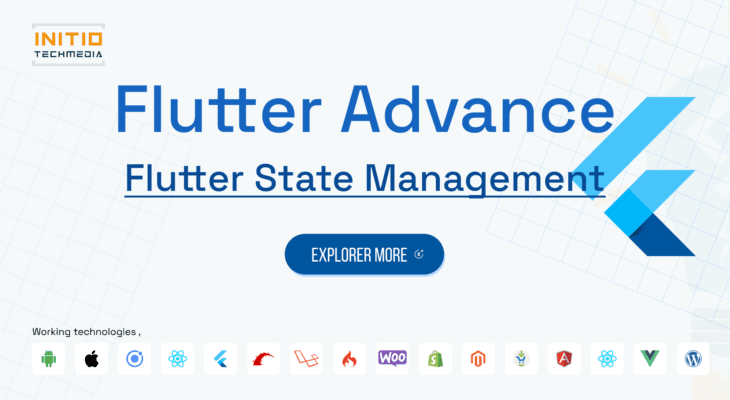Leading Mobile & web Development company which is providing Ready to publish apps & on demands application in Global Bussiness.
- 908, B Square 2, Ambli Rd, near Hotel Double tree Hilton, Vikram NagarAhmedabad-380054, Gujarat, India
- (+91) 8758432204Give us a call
- contact@initiotechmedia.com24/7 online support

Flutter State Management: An In-Depth Exploration of Top Libraries — Provider, Bloc, MobX, Redux, GetX, Riverpod, and Cubit.
- payal patel
- March 22, 2023
- 0
Learnt how to efficiently manage sate in your Flutter applications using the most popular state management libraries, including Provider, Bloc, MobX, Redux, GetX, Riverpod, and Cubit. Explore their features, advantages, and use cases, and discover the best practices for choosing the right library for your project.
Flutter is a powerful mobile application development framework that has become increasingly popular in recent years. One of the key strengths of Flutter is its ability to provide a rich and engaging user experience through its modern and flexible user interface toolkit. However, with great power comes great responsibility, and one of the challenges that developers face is managing the state of their application.
In the context of a Flutter application, state refers to the data that is used to represent the current state of the user interface. For example, a shopping cart application might have state that represents the items that have been added to the cart, the total cost of the items, and so on. State management is the process of managing and updating this data as the user interacts with the application.
Flutter provides several built-in state management solutions, including the StatefulWidget and StatelessWidget widgets. These widgets allow developers to manage the state of their application using simple, declarative code. However, as applications become more complex, managing state with these widgets can become cumbersome.
To address this issue, the Flutter community has developed several state management libraries that provide more powerful and flexible solutions for managing state. In this blog, we will take a closer look at some of the most popular state management libraries available for Flutter.
1. Provider : Provider is one of the most widely used state management libraries in the Flutter community. It is a simple and easy-to-use library that provides a way to manage state in a more efficient and scalable manner. Provider uses a concept called “InheritedWidget” to propagate changes in state down the widget tree. This allows for efficient updates to the user interface without the need for rebuilding the entire widget tree.
2. MobX : MobX is a state management library that uses observables and reactions to manage state. It is based on the principles of reactive programming and provides a way to automatically update the user interface when the underlying state changes. MobX is particularly useful for applications with complex state and dynamic user interfaces.
3. Redux : Redux is a state management library that has gained a lot of popularity in the web development community, and has been adapted for use with Flutter. Redux is based on the principles of a unidirectional data flow, and provides a way to manage state using actions and reducers. This approach makes it easy to understand how state changes occur, and provides a clear separation between state and UI logic.
4. GetX : GetX is a state management library that provides a complete solution for managing state in a Flutter application. It includes features for routing, dependency injection, and state management. GetX uses a reactive programming model to automatically update the user interface when the underlying state changes. It also provides a simple and intuitive syntax for managing state that is easy to learn and use.
5. BLoC : BLoC (Business Logic Component) is a state management library that separates the presentation layer from the business logic layer. It provides a way to manage state using streams, and provides a clear separation between the user interface and the underlying state management logic. BLoC is particularly useful for large and complex applications that require a more modular approach to state management.
6. Riverpod : Riverpod is a relatively new state management library for Flutter that is gaining popularity due to its simplicity and performance. It is built on top of Provider, and provides a more intuitive and concise syntax for managing state. Riverpod also supports dependency injection, which makes it easy to manage the dependencies of your application.
7. Cubit : Cubit is a state management library for Flutter that is based on the BLoC (Business Logic Component) pattern. It provides a simple and intuitive way to manage state using streams and stream controllers. Cubit is particularly useful for managing complex application logic that needs to be shared across multiple components.
In conclusion, Flutter provides several built-in state management solutions that are suitable for simple applications. However, for more complex applications, it is important to use a more powerful and flexible state management library. The five libraries discussed in this blog are all excellent choices for managing state in a Flutter application. Developers should carefully evaluate the features and benefits of each library to determine which one is best suited to their specific needs.
WhatsApp us

